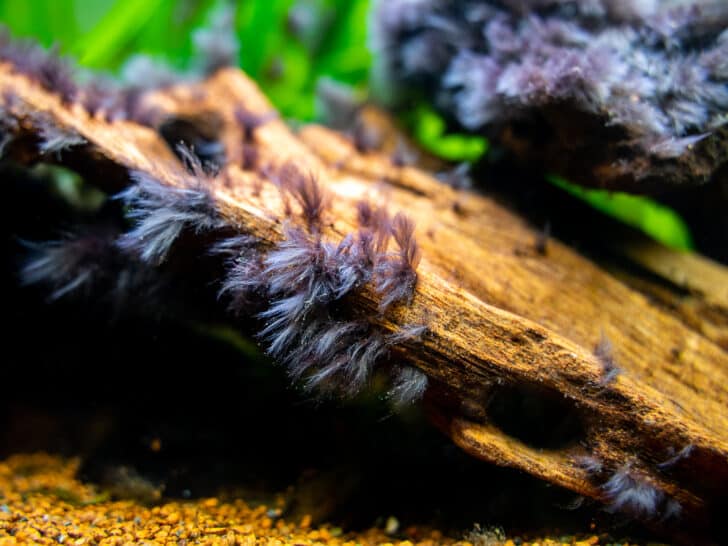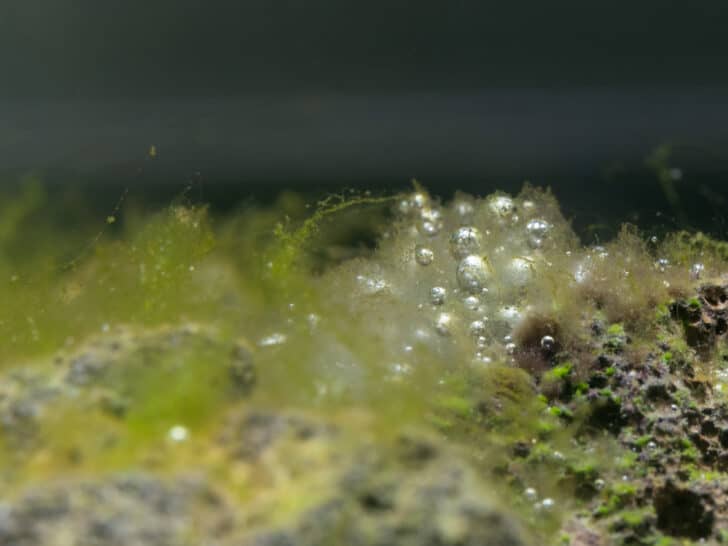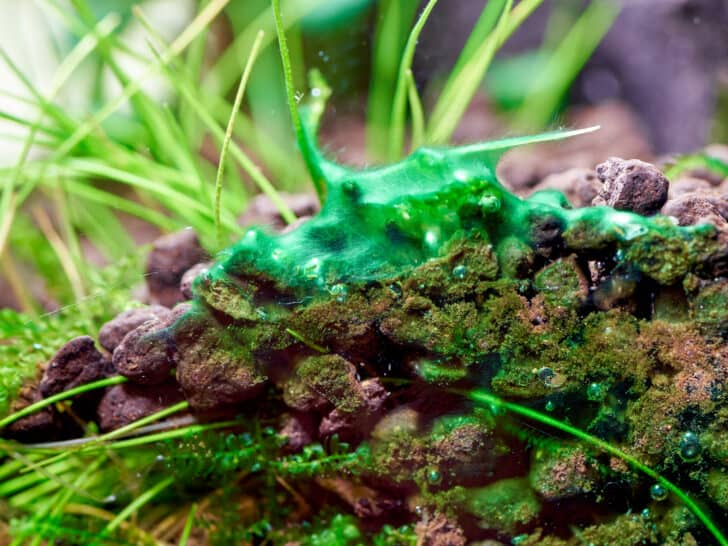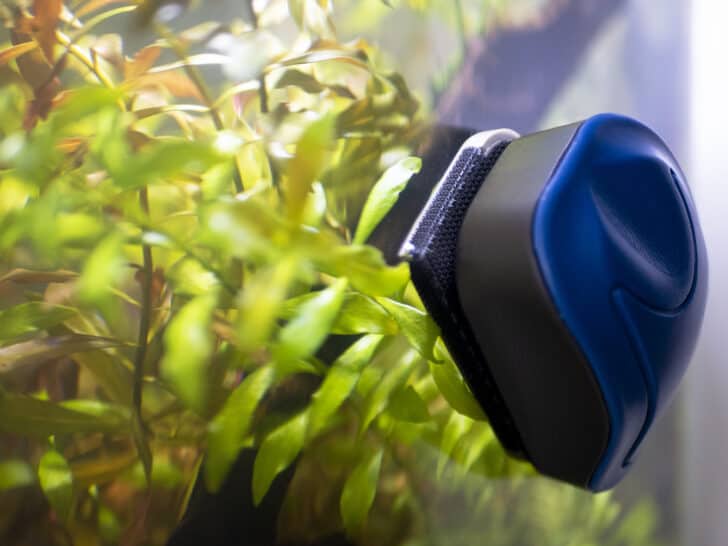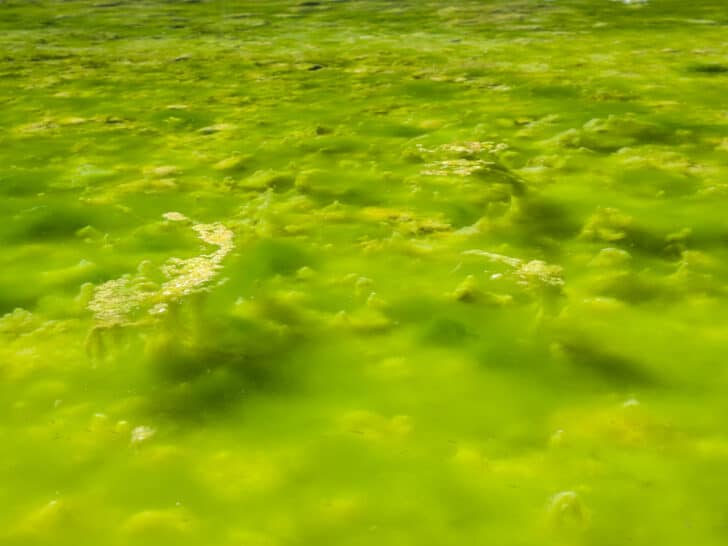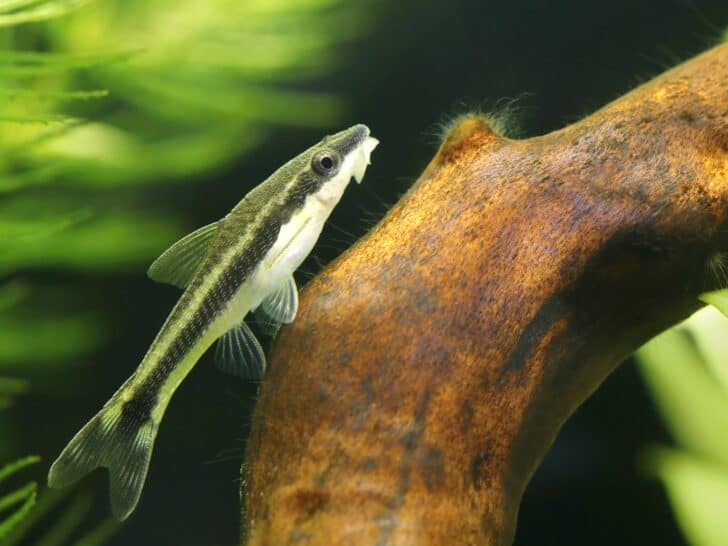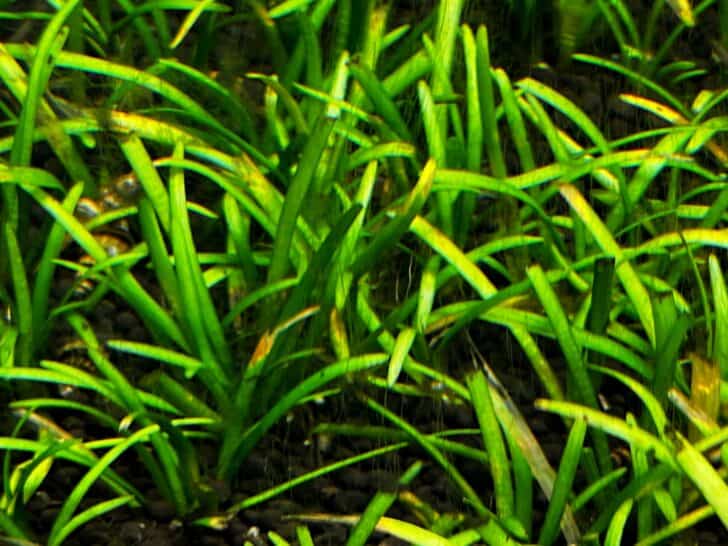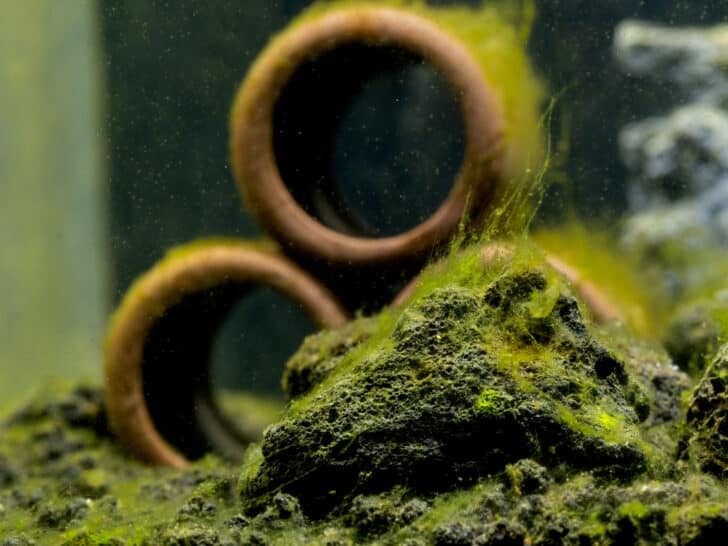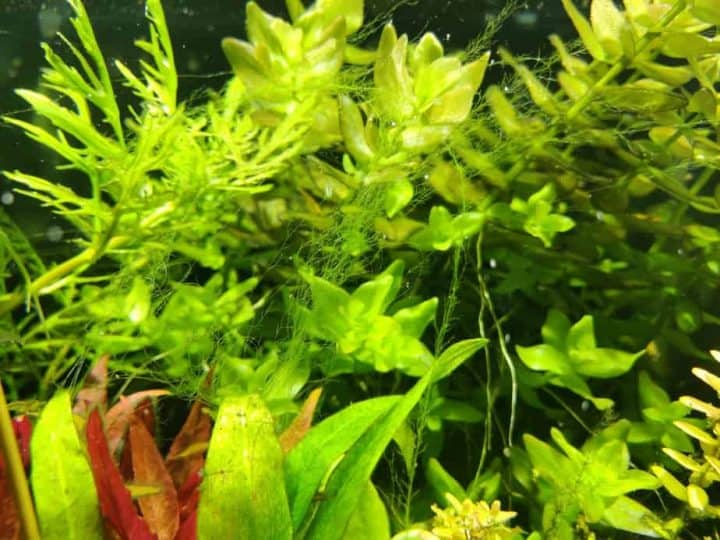One of the biggest problems I’ve ever had to deal with in an aquarium is algae.
Some common types of aquarium algae include green beard, brown diatom, black beard, green spot, hair, green water, blue-green, green dust, green fuzz, and staghorn algae. Algae blooms in tanks may be caused by either too much or too little light, unideal nutrients, a lack of maintenance, and more.
Today, I’m going to cover the 10 most common types of algae found in aquariums, what they look like, why they occur, and what you can do about them.
What is Algae?
Before we start talking about the most common types of aquarium algae, you first need to know what it is.
Algae are just a variety of plants that do not have flowers, stems, or roots. They may not have leaves, but they do engage in photosynthesis in order to grow and multiply.
There are some types of algae found in aquariums that are technically not types of algae, rather types of bacteria, although the two terms are sometimes used interchangeably on this front.
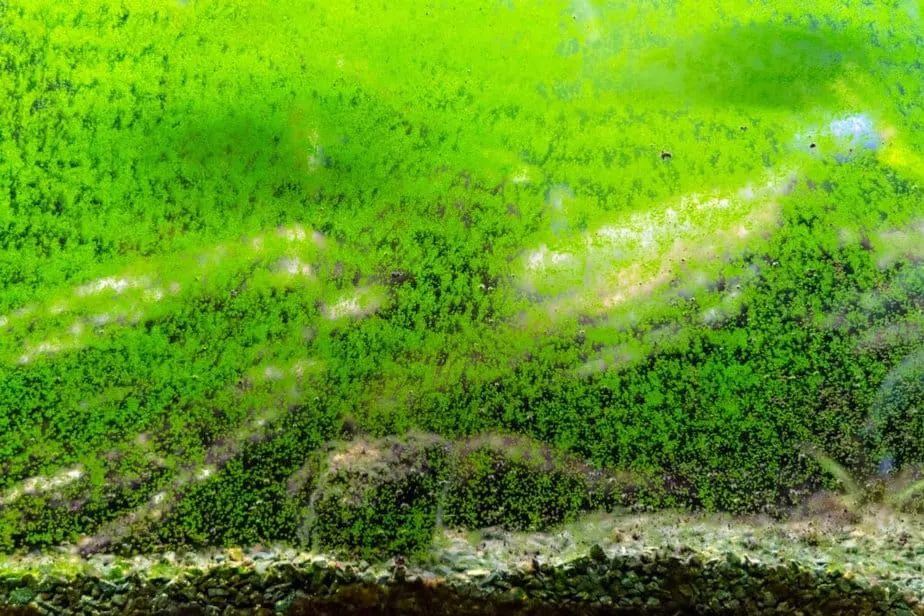
Furthermore, algae are single-celled life forms that are microscopic in nature, so they can easily find their way into your tank through water, air, on live fish, live plants, or even on aquarium decorations.
10 Common Types of Aquarium Algae
There are 10 main types of aquarium algae that you might encounter, and right now I want to take a look at all of them.
1. Green Beard
Green beard algae looks exactly like it sounds, long, green, and fuzzy beard.
This type of algae is often caused by a photoperiod that is too long, by low nitrate levels, or by low carbon dioxide levels.
This is not a particularly bad type of algae, but it can eat up too many nutrients in the tank and deprive your fish.
Amano shrimp, rosy barbs, and mollies Are all fish known for eating this type of algae.
2. Brown Diatom
Brown diatom is a type of algae that looks like small brown specks floating around in the water, which also adhere to various aquarium decorations.
This is one of the most common types of aquarium algae, and it’s also relatively harmless.
It often grows in new aquariums, and usually goes away on its own without any treatment.
Although, common causes of it include high silicates, low carbon dioxide levels, high ammonia levels, and low lighting levels.
Some plecos, shrimp, snails, and catfish like to eat brown diatom algae.
3. Black Beard
Black beard algae also looks exactly like it sounds, like thin and black beard hair that is slightly fuzzy in nature.
This is one of the hardest types of algae to get rid of, as it grows on plants, substrate, equipment, and everything in between.
The vast majority of fish also don’t eat this type of algae, which is a problem. It’s often caused by fluctuating carbon dioxide levels as well as a high water flow.
The good news however is that this type of algae doesn’t really pose much of a threat to your aquarium inhabitants.
However, if this algae covers the leaves of your aquarium plants, it can effectively suffocate them.
4. Green Spot
We then have green spot aquarium algae. As the name implies, this type of algae takes the form of small to moderately sized green spots.
It often grows on slow growing aquarium plants, on the glass or acrylic tank walls, and on smooth and flat aquarium decorations or equipment.
The bristlenose pleco and nerite snails are two of the only aquarium animals that will eat this type of algae.
It can be fairly difficult to remove, although hydrogen peroxide seems to do the trick. The number one cause of green spot algae growth is a phosphate deficiency.
5. Hair Algae
Although green hair algae is not really dangerous to your fish, it can quickly overtake aquariums and suffocate your plants. As the name implies, it looks like long and green strands of hair.
This type of algae is most commonly known for growing on live plants, and if you find it growing, it’s often a sign that your aquarium plants are not being fertilized properly and are not in good health in general.
Unhealthy plant growth and nutrient imbalances are the two main causes of green hair algae growth.
Otocinclus catfish, ramshorn snails, and amano shrimp are three of the biggest green hair algae eaters.
6. Green Water
If you notice that your aquarium water is turning a very vibrant shade of green, almost turquoise, then you likely have green water algae, which is technically a bloom of phytoplankton, a microscopic type of algae.
Having too much UV light, a lack of tank maintenance, or a nutrient imbalance are the three main causes of green water algae growth.
Using a UV light filter is generally considered the easiest way to get rid of this type of algae.
Although this type of algae is not overly harmful to your fish or other aquarium inhabitants, it can easily overtake a tank and block your aquarium plants from getting sufficient amounts of light.
7. Blue-Green
Here we have what is known as blue-green algae, which is one of the few types of aquarium algae that is actually harmful to your fish.
This type of algae can produce a variety of toxins which can be harmful to both the plants and fish in your aquarium, and if left untreated, may kill everything inside of the tank.
This blue-green algae takes the form of a slimy substance or slimy layer that can cover plants, aquarium fixtures, and more.
Technically speaking, this is technically not a type of algae, but rather a type of bacteria known as cyanobacteria.
It’s not overly difficult to remove, but if you don’t figure out what’s causing it in the first place, it will keep growing back.
It is most commonly caused by low levels of nitrates.
Furthermore, most types of fish will not eat this type of algae. Although, ramshorn snails are known for eating it.
8. Green Dust
Green dust algae looks similar to green spot algae, although it tends to float around in the water more than it does adhere to aquarium fixtures.
It will settle on surfaces and the glass, but it is known for floating around, with the good part being that it is very easy to wipe out of your tank.
This type of algae bloom is caused by having either too much light, a lack of other plants, or a nutrient imbalance.
Three creatures known for eating green dust algae include nerite snails, otocinclus catfish, and bristlenose plecos. Luckily, this type of algae is considered relatively harmless.
9. Green Fuzz
Green fuzz algae takes the form of very light green fuzz that can cover rocks, plants, substrate, and more. It almost looks like very fine Moss.
This filamentous green algae grows mostly on unhealthy plants, with both a nutrient imbalance and a lack of carbon dioxide causing this type of algae bloom to occur.
Balancing the nutrients and adding some CO2 to the tank are the two best ways to get rid of this type of algae, although cherry shrimp, amano shrimp, mollies, and other creatures will eat it.
Although green fuzz algae can quickly overtake a fish tank, it is generally not considered harmful to the inhabitants.
10. Staghorn
Staghorn algae grows in gray clumps, and it looks somewhat similar to black beard algae, although lighter in color, and generally lumpier in nature.
This type of algae usually grows on the edge of plant leaves, and it can be very difficult to remove.
It might not be dangerous to your fish, but it certainly doesn’t look very nice.
Making sure to support proper plant growth and preventing ammonia spikes from occurring, are the two best ways to prevent staghorn algae from growing.
Main Causes of Algae Blooms in Aquariums + Solutions
The issue with algae blooms in aquariums is that they can be caused by a wide variety of issues, so let’s take a quick look at the most common ones.
Low Water Circulation
If you have dead spots in your aquarium, which are areas in the aquarium where there is not much water flow, organic waste can build up, therefore providing algae with the perfect growth conditions.
Installing air stones, powerheads, or more powerful filters is a good way to take care of this issue.
Poor Biological Water Filtration
Another main cause of an algae buildup in aquariums is a lack of proper filtration.
You need to keep the nitrogen cycle running properly, characterized by millions and millions of beneficial bacteria.
If you have an old filter, or the biological filtration media is no longer viable, it’s time to make an upgrade or a replacement.
Having a good aquarium filter is one of the best ways to prevent algae from occurring.
CO2
Carbon dioxide is a difficult one, because both too little and too much of it can in some cases cause algae growth to occur.
Finding the ideal level is therefore extremely important.
Sunlight
Just like regular plants, algae perform photosynthesis, which means that they need sunlight.
Therefore, the more UV sunlight you provide your fish tank with, the more likely it is that algae blooms will occur.
The easy solution here is to therefore decrease the amount of light you provide your time with.
Various Water Parameters + Unhealthy Plants
Aquarium plants use nutrients, carbon dioxide, and light to grow.
If you provide your tank with plenty of all three, but your plants aren’t healthy, maybe because the levels of those three factors aren’t ideal for the specific plants you have, algae blooms may occur.
The light, carbon dioxide, and nutrients, if they aren’t being used by plants, may then be used by algae.
The solution here is to make sure that you provide your aquarium plants with the proper conditions and parameters so that they can easily grow and use these sources of energy, so that algae does not have access to them.
The Water Source
If the water source you are using is rich in silicates, phosphates, and nitrogen, it may also cause algae blooms to occur.
Therefore, before adding water into your fish tank, you should always use some sort of conditioner, or even a reverse osmosis system can be beneficial on this front.
A General Lack of Maintenance and Poor Water Conditions
Algae really like ammonia as well, and ammonia builds up in tanks when there is decaying plant matter, uneaten food, and lots of fish waste.
Generally, a lack of good water filtration is to blame here.
You need to have a functional mechanical aquarium filter that removes all sorts of solid debris from the water.
This will prevent organic from breaking down and releasing ammonia into the water, and in turn prevent algae blooms in the aquarium.
On that note, to remove excess nutrients from the water, perform regular water changes and clean the aquarium regularly. You should also prevent overfeeding the fish. These testing strips can come in very handy for keeping track of various water parameters.
Conclusion
As you can see, there are many different types of algae that can grow in an aquarium, and I didn’t even talk about all of them today.
That said, the vast majority of algae growths in aquariums are relatively harmless to your fish, although they can quickly take over a tank and block your plants from getting light.
Once algae blooms occur, they can be somewhat difficult to get rid of, so the best method of all here is prevention.

